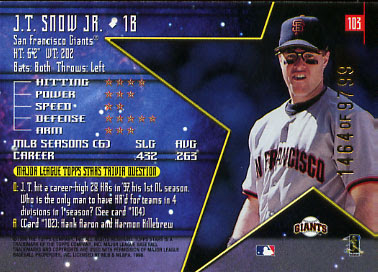In case you don't go back and check my methodology here's a brief recap. I started with 256 different card sets issued in the 1990s. I randomized the sets, and broke them into four 64-card divisions, Babe Ruth, Mike Schmidt, Ted Williams and Nolan Ryan. I'm pitting cards against each other in a bracket system, breaking each division into quartiles. We're currently working on the 2nd Quartile of the Babe Ruth Division. Here's where we left off last week.
Today we've got
1998 Topps Stars vs. 1999 Bowman's Best.
1998 Topps Stars #38 Johnny Damon
1998 Topps Stars #103 J. T. Snow
Also known as Topps Stars Red, this is the 150-card base set of yet another set with multiple levels. After Red you have Bronze, Silver and Gold. Note that even the base set is serial numbered to 9,799. The Bronze set is also numbered to 9,799, the only difference being the color of the printing at the top of the card. Silver and gold are numbered to lesser amounts. Someone commented on my 1998 Topps Gold Label post about Topps gimmick cards of the 1990s which was my thought exactly. Topps did a lot of this in the later part of the decade. Think Topps Lazer, Topps Tek etc. This card is kind of attractive in person. What doesn't come through in the scan is that the card front is embossed with parallel lines running from top to bottom.
1999 Bowman's Best #3 David Justice
1999 Bowman's Best #168 Nick Johnson
This 200-card set featured either a gold front (for veterans) or a blue front (for prospects) overlaid with a heavy gloss. The color scheme continues on the back. This was in the days when the card companies could pluck a player out of the minors and call him a rookie. I like the backs but really don't like the fronts. I'll grant that they look much better in person but I'm not a big fan of cards showing action photos over top of some abstract background. The center diamond is a foil rendered continuation (probably) of the photo but I don't like that either.
The Result: As you can probably tell I'm not a big fan of either of these cards but I dislike the Bowman's Best more so, 1998 Topps Stars wins this round.





















































